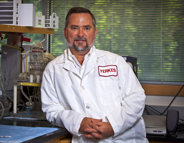 |
 |
|||||||
| August 28, 2013 | Research Extras Read about a new cancer biology graduate program meant to immerse young scientists in research much earlier in their education. The program is a partnership between the Winship Cancer Institute and the Laney Graduate School. The new Lab Land blog highlights research and discoveries in biomedical laboratories in the Woodruff Health Sciences Center. The largest cystic fibrosis clinic in the nation, shared by Emory School of Medicine and Children's Healthcare of Atlanta, includes research efforts focused on new drug therapies and devices to improve quality of life and longevity. Many more CF children are reaching adulthood and are treated at Emory through one of the few adult CF centers in the Southeast. Emory will lead a new NIH-fund National Center for Functional Glycomics, focused on an "omics" field that covers all the carbohydrates in the human body and their interactions and links to disease. Read about the drug discovery success of a recent graduate of the ACTSI Certificate Program in Translational Research. The new program, part of Emory's Laney Graduate School, gives investigators the skills to translate their research from basic science into clinical medicine.
|
|||||||
New Genetic Risk Factor Found for Schizophrenia |
||||||||
Chronic Stress Causes Biological Changes in Pregnant Women |
||||||||
 |
||||||||
Oxytocin Could be Basis of Improved Autism Treatment |
||||||||
Lampreys Provide Hints to Immune System Evolution |
||||||||
Eye Movement Rhythm Important to Eye-Tracking Diagnosis |
||||||||
 |
 |
|||||||



